Gluten Free Italian Recipes
By Samantha Bauer
Updated November 3, 2021
The Italian Misconception
When I first informed my friends and family that I would be studying abroad in Italy for a month to study the Mediterranean Diet, their initial response was, “What are you going to eat?” They all know I have been gluten-free (GF) for a year and while they were excited for my opportunity, it was clear that images of pizza, pasta, and grains were flying through their heads. I was going to need some gluten free Italian recipes.
I went into this program with a similar preconceived notion; that I would have to resort to eating vegetables, fruits, and meats or fish and, of course, gelato and restrain from indulging in the Italian cuisine as we know it in the United States. While I was aware that the Mediterranean Diet consisted of other foods besides gluten-containing grains, it is hard to fully understand the diet and the lifestyle it embodies without truly experiencing it.
I have learned that the Italian diet is more of a lifestyle and features a vast array of products to satisfy all eating restrictions and taste preferences while also maintaining a delicious and healthy food culture.
Here are some popular Italian foods which are not gluten free.
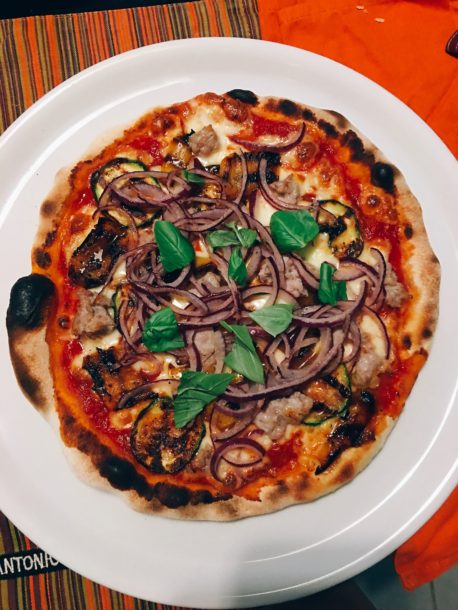
Italian Pizza
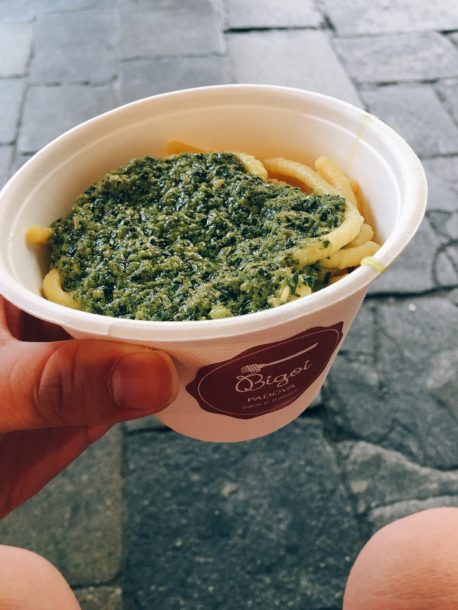
Italian Pesto Pasta
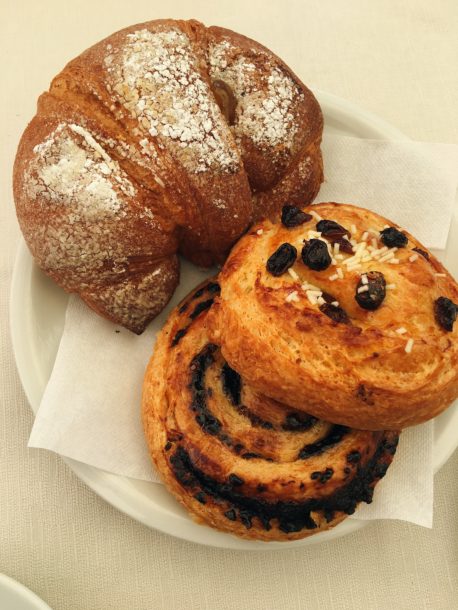
Croissant and Pastries
While it is not wrong to believe that Italians eat pasta and pizza, it is important to understand that they are not limited to these foods and their diets are much more than carbohydrates, cheese, and gelato. They have many traditional gluten free Italian recipes that are super delicious.
Reality of Italian Cuisine – The Mediterranean Diet
Italy falls within the Western Mediterranean region along with France, Spain, and Malta. The diet in these countries consists of lots of vegetables, high amounts of cereals, fruits, olive oil, cheese and alcohol.
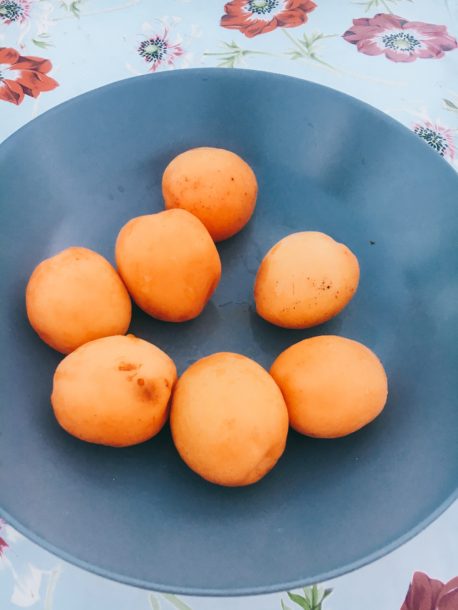
Apricots from my host family’s tree
Wine is commonly drunk with dinner and in moderation.
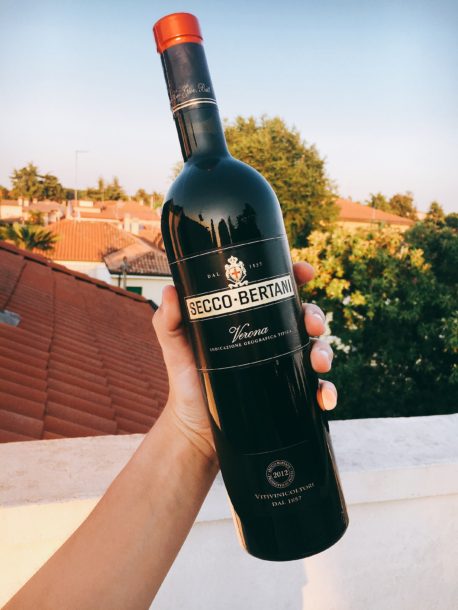
Red wine from Verona
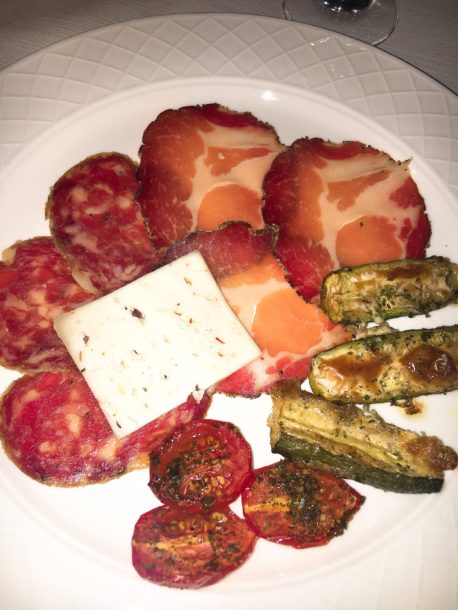
Meat, cheese, and grilled vegetables from an agrotourismo in the hills outside Padua
This is the reality of Italian cuisine.
Italian food is not limited to commercialized pizza and pasta. The Mediterranean Diet is a cultural eating experience that emphasizes conviviality (eating meals together), traditions, climate, food sources, biodiversity, sustainability, local production, frugality and a physical lifestyle. All of these aspects go into creating a way of life for people to truly enjoy food as an expression of social and communal practices.
With this said, a gluten-free diet is certainly attainable within this lifestyle while still following the Mediterranean diet. Gluten is found in common cereals, but there are many other grains that are naturally gluten free. For those who are less educated about these types of safe grains, there are many foods in grocery stores and in restaurants that are labeled “Senza glutine,” which translates to “without gluten.” This makes cooking at home and eating out in Italy very possible and accessible to those with this dietary restriction who wish to maintain the Mediterranean Diet.
Grains Are an Essential to the Mediterranean Diet –
Gluten Free Eaters Are Not Left Out!
The Mediterranean Diet incorporates many different types of cereals and emphasizes a mixture of whole grains. The suggested food pyramid for this region suggests that cereals be consumed at every meal in the day. This, at first, can become problematic for someone trying to avoid gluten-containing products. But! With the knowledge I learned from my class on the Mediterranean Diet and the detailed labeling on food products, I found that buying gluten-free foods was not an issue and is super affordable and available!
Here is a break down of whole grain cereals that are naturally gluten free and are for the most part readily available in stores:
- Amaranth
- Buckwheat
- Corn
- Millet
- Rice (brown and colored)
- Wild rice
- Oats
- Quinoa
- Sorghum
- Teff
It is helpful to have an understanding of these types of grains as many products are made from these cereals and are gluten free even if the package does not specifically say. Therefore, a whole grain serving per meal is attainable with a variety of ingredient choices to suite your favorite taste! These are great substitutions for most gluten free Italian recipes.
Buying Gluten Free in the Store
Buying foods in a foreign country is daunting given the language barrier, let alone the stress that comes along with determining if a food has certain ingredients. The key to learning how to shop in an Italian market or grocery store is to learn how to say gluten free and how to identify the different grain types. I found it useful to also download the Google translator application and Italian dictionary in case there is no Wi-fi and to translate ingredients.
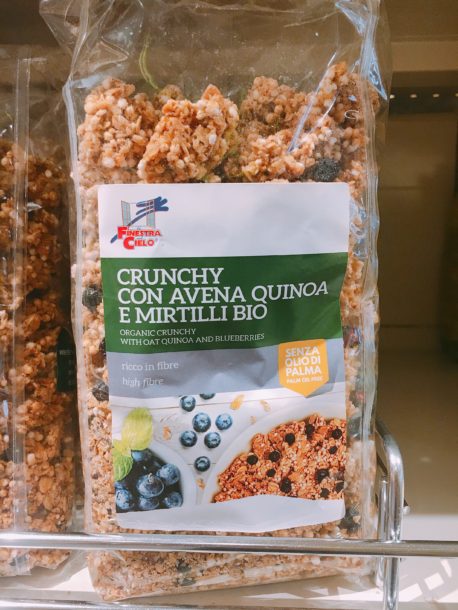
Quinoa from an Italian Grocery Store
My first experience in a grocery store was with my class in a grocery store called Ecor Natura Si, which sells local and fresh products. Here I was able to identify many of these cereals within the first isle of the store. I also found foods made from these natural gluten free grains, such as rice crackers, bread made from quinoa, quinoa cookies…etc. One of my favorite products I bought at this store was a granola made from quinoa and oats, mixed with blueberries!
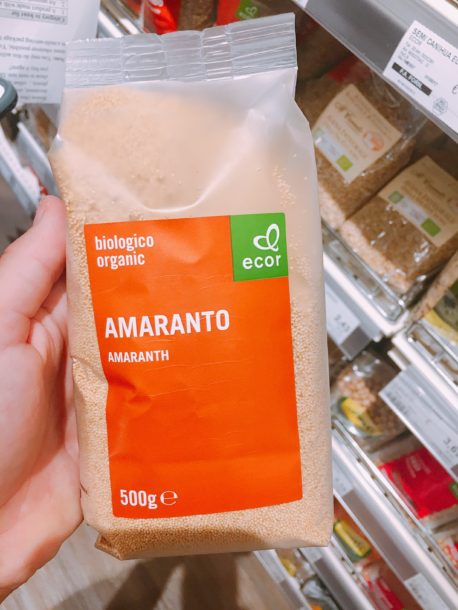
Amaranth from an Italian Grocery Store
There is also a small gluten free section in the back of the store that organizes these products in one space. This is helpful for those who do not know which grains are safe or who do not have the time to search the shelves for alternative grains.
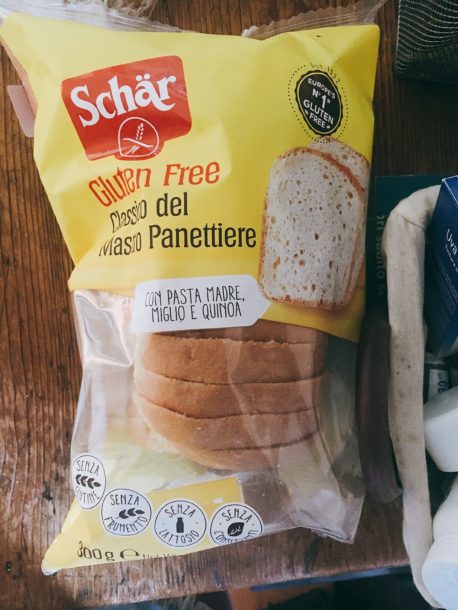
Gluten Free Bread from an Italian Supermarket
Eating in Gluten Free
As part of the BU program, I lived with a host family. They were aware of my dietary restrictions and accommodated their cooking style to meet my needs.
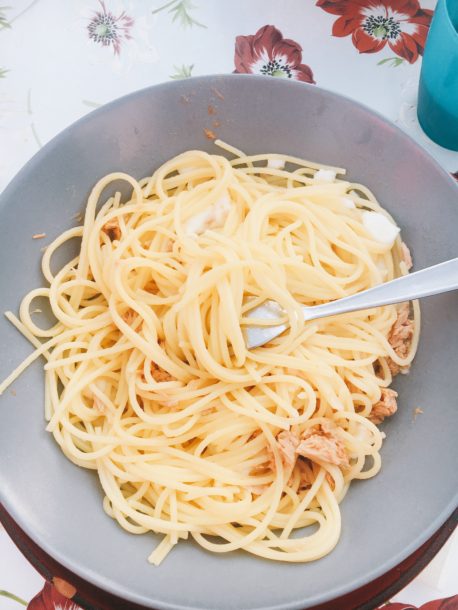
Gluten Free Pasta
Listed are typical weekly meals prepared homemade with gluten free products that also fall within the Mediterranean diet (naturally):
| Course | Monday- 6/19 | Tuesday- 6/20 | Wednesday- 6/21 | Thursday- 6/22 |
| Appetizer | Salad with tomatoes, feta cheese, olives, olive oil | Gluten free whole grain spaghetti, tuna fish, mozzarella, olive oil | White rice in tomato sauce | White rice in olive oil |
| 1st | Guineafowl marinated in olive oil | Cabbage with olive oil | Sliced eggplant with goat cheese and tomato sauce | Zucchini from their garden, olive oil
|
| 2nd | Zucchini from their garden, olive oil
|
Dish common to Southern Italy “mozzarella in carrazzo” (fried, GF bread, eggs, mozzarella) | Zucchini from their garden, olive oil
|
Chicken breast, olive oil |
| 3rd | Salad with arugula, carrots, tomato, olive oil | NA/ | Local bass, olive oil | NA/ |
| Dessert | Watermelon, peaches, dark chocolate | Apricots from their tree, white peaches with brown sugar | Gelato from my families favorite store, Panciera | Sliced peaches with brown sugar |
| Drink | Water | Tuscana Rosale (Rosè), Water | Prosecco, Water | Sparkling water |
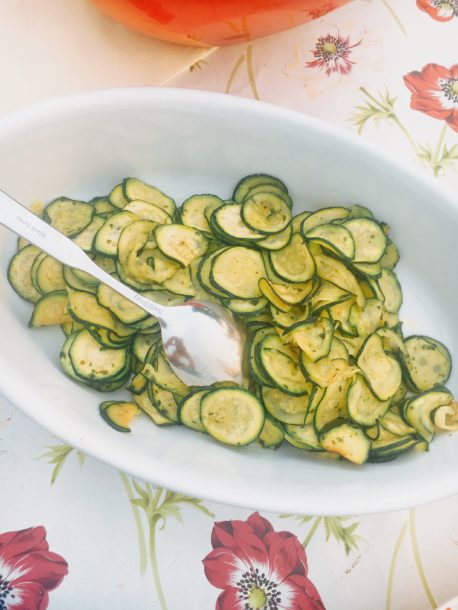
Zucchini made by my host family
I ate the same meals as my host family, but the gluten free grains were substituted for “gluten-ful” cereals. For example, a pasta dish made from whole wheat pasta was prepared alongside a GF spaghetti made from rice. It was therefore very easy to incorporate different grains into homemade dishes without being too invasive as far as sticking to traditional meals and preparation.
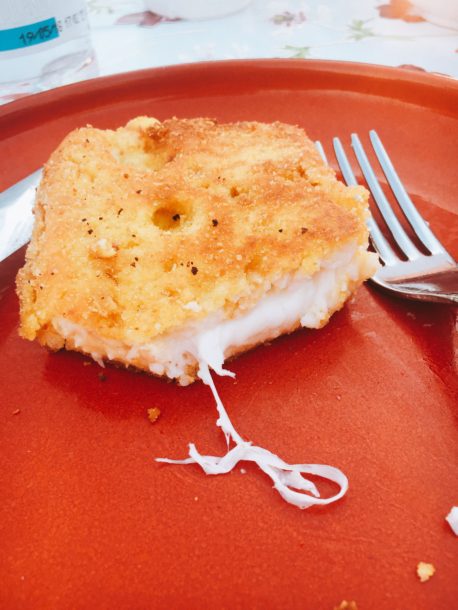
Italian Cheese made by my host family
Eating Out Gluten Free
Grains become the greatest challenge when trying to find gluten free options in a restaurant or cafe. After eating out in various places in Padua and travels to Lake Como, Venice, and Verona, I have realized that there are a variety of gluten free options that exist, incorporating grains like corn and rice as replacements.
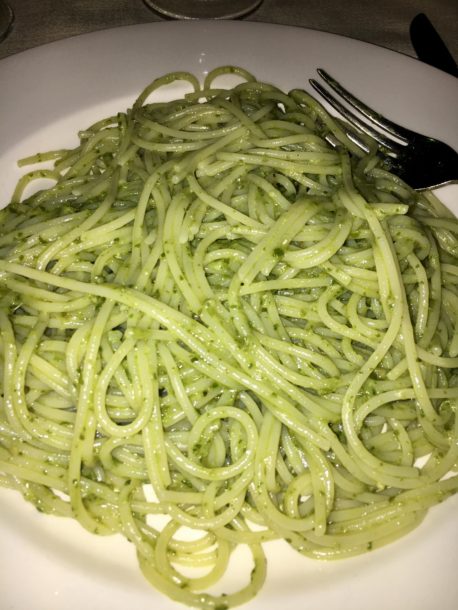
Gluten Free pesto pasta from a restaurant in Italy
I ordered many dishes from restaurants that use alternative gluten free cereals to make their food gluten free. In my experience, gluten free foods in the United States can have a brittle texture or tend to look visually unappealing, however, I found that Italians know how to make their gluten free foods look and taste fantastic!
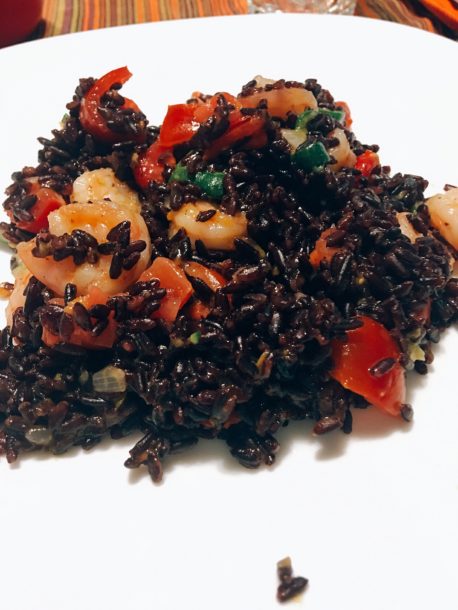
Mediterranean Black Rice ordered from an Italian Restaurant
On the downside, I was unable to find any form of bread products in restaurants as far as appetizer bread baskets and sandwiches served commonly in cafes. As a result, I chose to refrain from eating bread before a meal and to look for cereals that were gluten free naturally.
There are many gluten free Italian recipes available in restaurants and they usually offer grain dishes that are made from corn or rice.
Commonly found gluten free grains in restaurants:
- Rissoto (rice mixed in a cream sauce)
- Rice mixed with vegetables
- Polenta (corn based)
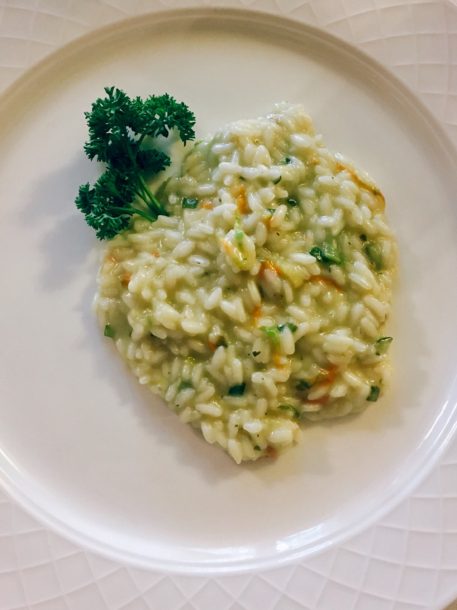
Gluten free risotto from Italian Restaurant
Limited to only certain restaurants:
- Gluten free pasta
- Gluten free pizza
Foods that are Perfectly Safe to Enjoy!
Here are some tasty foods that I enjoyed at home and out with almost zero safety concerns! While there are many foods that contain gluten on menus and in stores, there are also many different delicious gluten free Italian recipes that are completely safe to eat.
Some of my favorite food experiences were fruit, vegetable and fish dishes and of course gelato!
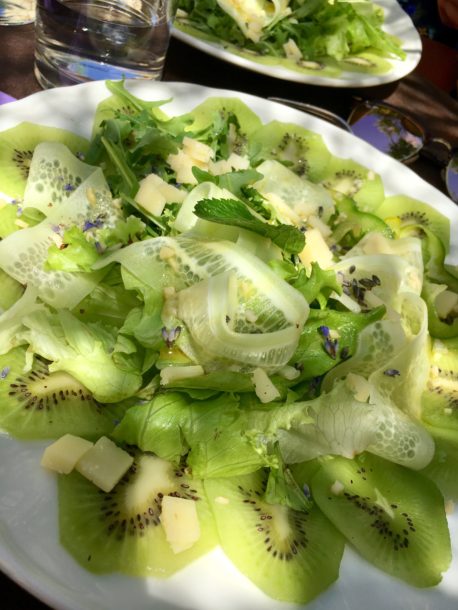
Kiwi Salad from Restaurant in Italy
The Mediterranean Diet emphasizes an abundance of vegetables, so salads and grilled vegetables are almost always offered in restaurants and because salads are typically self-dressed there are no concerns when it comes to the dressing contents. Olive oil and balsamic vinegar are typically used as dressing, which are both gluten free and are also members of the Mediterranean food pyramid as foods to eat with every meal.
Fish is also very common, the type depending on the season, and meat of all kinds is readily available. I decided to get a little adventurous with my seafood and try octopus! It was boiled and drenched in olive oil and pesto sauce adding a lovely nutty and warm flavor.
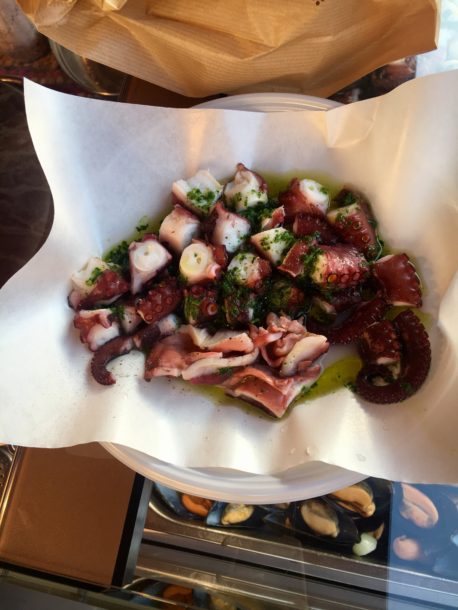
Octopus with Pesto from the Food Market
After a nice meal, whether it be at home or out at a restaurant, there is nothing better than cooling off and enjoying a scoop (or a few!) of gelato. There are gelato stores all over Italy and there is no shortage of people at any time of day walking around the city with their delicious dessert in hand. Fruit is also a common dessert in Italy and is, of course, gluten free and safe to enjoy!
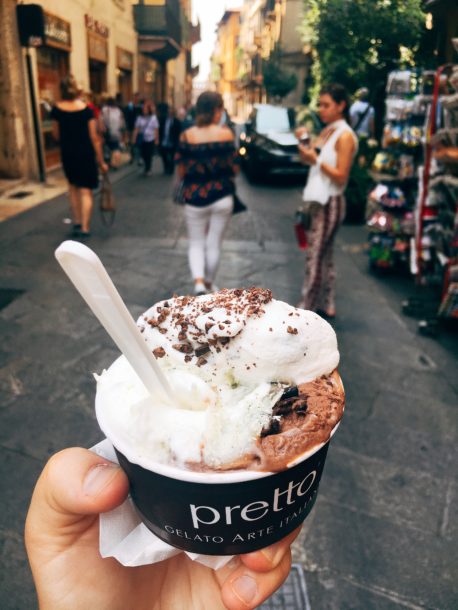
Gelato from Italian Vendor
Here are a few of my favorite spots in Padua. Highly recommended!
- La Romana
- Grom
- Panciera
- Venchi
I found that with a minimum amount of effort I was able to enjoy most of the incredible Italian Mediterranean Diet without any feelings of deprivation. If you have any concerns about going to Italy because you are gluten free, I think you will find an amazing culinary adventure ahead of you!
Check out our Gluten Free recipes on Mediterranean Living here.
SaveSave








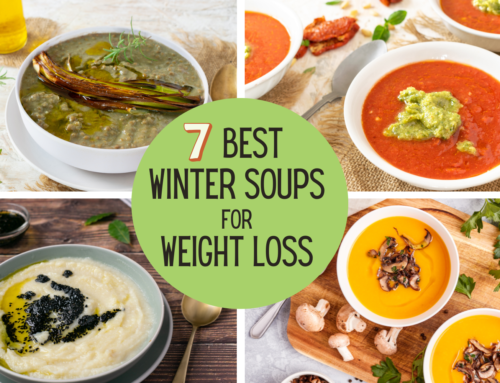

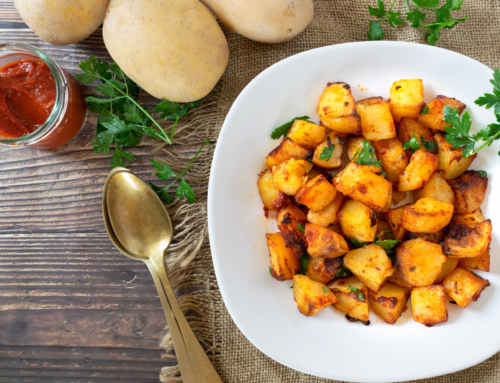
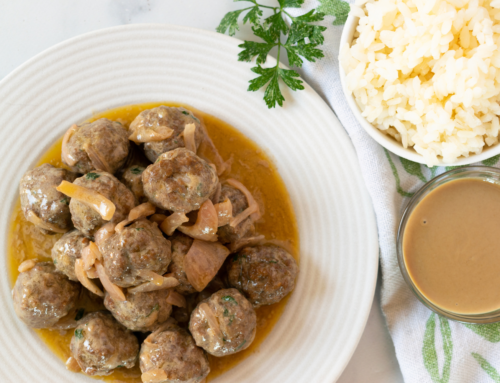
Bill Bradley, R.D. says:
Bill Bradley, R.D. says:
Bill Bradley, R.D. says: